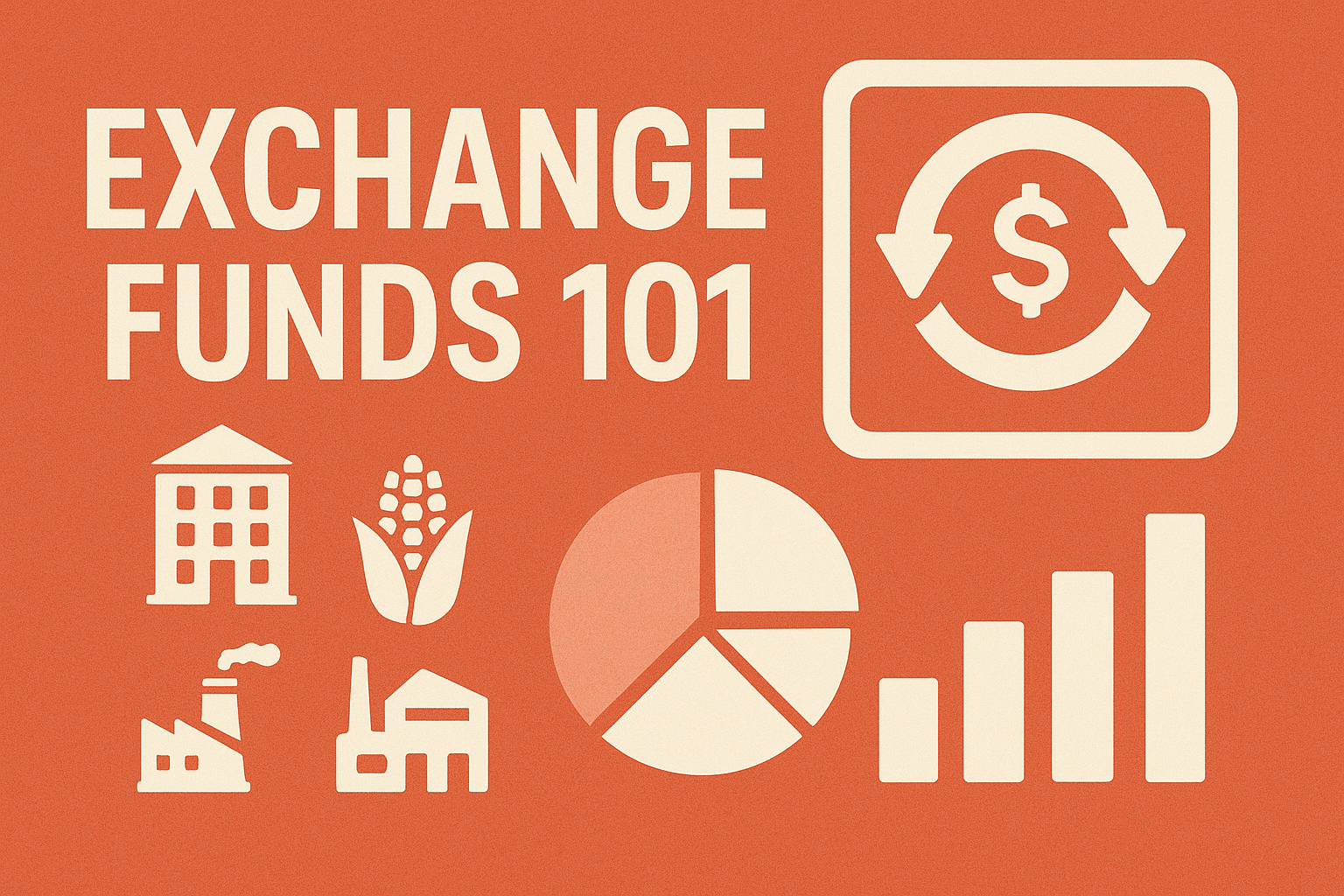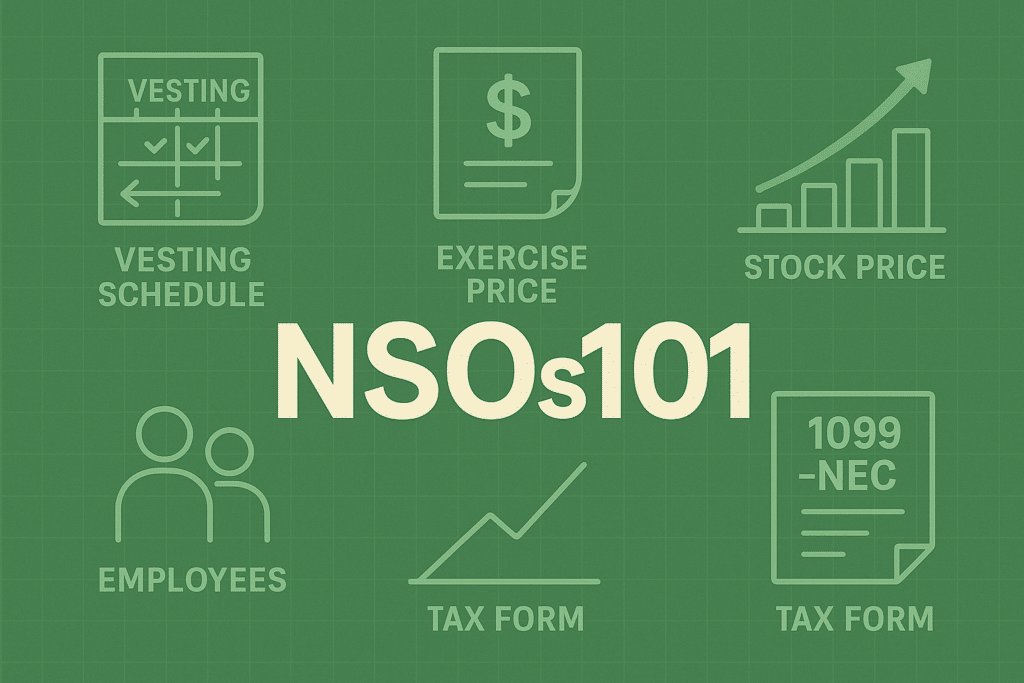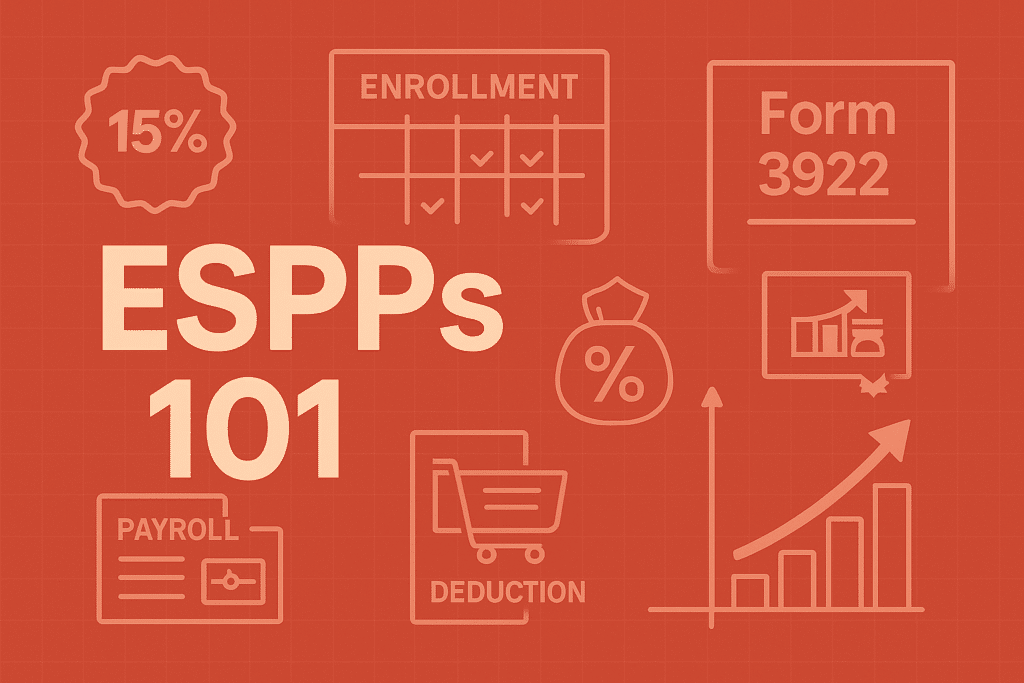Sitting on a big, low-basis stock position can feel great on paper but painful when you think about the tax bill to sell. Exchange funds offer a unique solution—pooling your shares with others to create broad equity diversification while deferring capital gains.
In this guide, we’ll step back and outline the fundamentals of how exchange funds are structured, the tax mechanics that make them work, and the types of investors who may benefit. The goal is to give you a clear framework for understanding where this strategy might fit into a broader wealth plan.
What Is an Exchange Fund?
An exchange fund (sometimes called a “swap fund”) is a private partnership that accepts contributions of appreciated stock from many investors and pools those positions into a diversified portfolio. In return, you receive partnership units that represent your slice of the pooled holdings rather than continued exposure to a single company.
Because you’re contributing property to a partnership rather than selling it, your built-in gain is generally deferred at contribution. You’re swapping concentration risk for broad exposure while postponing the capital-gains tax you’d owe if you sold outright.
These vehicles are private placements, not exchange-traded funds. They come with eligibility requirements, a multi-year holding period, partnership K-1 tax reporting, and a redemption that typically delivers a basket of stocks in kind rather than cash.
Key Design Features of Exchange Funds
While each sponsor may set its own terms, most exchange funds are built around a similar set of structural features. Understanding these common elements up front helps set realistic expectations and clarifies the trade-offs involved:
Minimums and eligibility: Minimum contributions often run from the mid-six figures to $1M per position. Participation is typically limited to qualified purchasers and accredited investors. Confirm that your shares are eligible (public, marginable, and not restricted).
Stock-acceptance limits: To keep diversification intact, sponsors cap how much of any one stock the fund will hold. Highly concentrated names may be accepted only up to a quota, which can affect timing.
Fees and liquidity terms: Management fees (often north of 1%) and possible placement fees are common. Redemptions are typically in kind after seven years; early exits may be penalized and can return your original stock.
What you still own economically: You’ll still have some exposure to your contributed company because it remains in the pool, but it’s heavily diluted by other positions and the illiquid sleeve. That’s the point—less single-name risk, broader equity exposure.
The illiquid sleeve: Expect a real-asset or private-partnership sleeve of roughly 20% or more. Each fund is required to have illiquid assets in every exchange fund to pair with the stocks.
How an Exchange Fund Works
Before you compare strategies, it helps to see the mechanics from contribution to redemption. The flow below shows where diversification shows up, where tax deferral comes from, and where trade-offs live:
Step 1) You contribute appreciated stock: You transfer low-basis shares into the partnership instead of selling them. In return, you receive partnership units. No cash changes hands, and your original cost basis follows you inside the structure.
Step 2) The fund pools everyone’s positions: Your units now reference a diversified portfolio built from many investors’ contributed stocks (and, usually, an additional sleeve of “illiquid” assets). You’ve reduced single-name risk and gained broad exposure.
Step 3) The fund maintains an illiquid sleeve: Most exchange funds keep a meaningful allocation—often 20% or more—in qualifying illiquid assets (commonly real-asset or real-estate partnerships). This design choice supports the fund’s tax structure and adds a different return stream.
Step 4) You commit to a long holding period: Expect a seven-year commitment before a tax-efficient redemption. This timeline aligns with partnership “mixing bowl” rules and keeps the original built-in gain deferred.
Step 5) After seven years, you redeem in kind: Instead of cash, you typically receive a basket of stocks. That basket is diversified and generally excludes the exact shares you contributed. Your aggregate basis carries over, and you realize gains later only as you sell the distributed positions.
The Tax Rules Doing the Heavy Lifting
The reason exchange funds can defer your taxes comes down to a few partnership rules. You don’t need to know the code numbers, just the basic ideas:
No tax when you contribute shares: Normally, selling stock would trigger capital gains tax. But when you contribute shares to a partnership, it’s not treated as a sale. That’s why you don’t pay tax when you first move stock into the fund.
The 20%+ “illiquid sleeve” is intentional: If the IRS were to view the fund as just an investment company, your contribution could be taxed right away. To avoid this, exchange funds are designed with a significant slice (often 20% or more) in illiquid assets like real estate. That structure keeps your contribution tax-deferred.
The seven-year rule: The IRS has special rules for contributed property with built-in gains. The seven-year holding period lines up with these rules so that when you redeem, you get a diversified basket without being forced to recognize the original gain early.
Your cost basis carries over: After seven years, the cost basis from your original stock follows you into the basket of stocks you receive. You’ll owe taxes only when you choose to sell the new shares, and you control the timing.
Annual K-1 reporting: Each year, you’ll get a Schedule K-1 showing your share of any income, dividends, or expenses. The paperwork can be a bit more complex, but your big built-in gain still stays deferred.
Who Typically Benefits (and Who Doesn’t)
Exchange funds solve a specific problem: “I’m over-exposed to one stock, my basis is low, and a simple sale triggers a big tax bill.” They also come with real trade-offs—eligibility thresholds, fees, K-1s, and a seven-year clock. Let’s quickly review what a typical best fit looks (and doesn’t look) like.
Good Candidates
Exchange funds are usually best for those who have:
Large, low-basis positions: If a single position dominates your portfolio and carries substantial unrealized gains, an exchange fund can reduce concentration in one move while deferring tax. This is common for public-company executives post-IPO, long-tenured employees whose RSUs compounded for years, and early investors who rode a big winner.
High and recurring equity inflows: If you keep receiving stock through vesting or option exercises, trimming around the edges may not move the needle. Contributing a slice to an exchange fund can reset the starting point, after which a 10b5-1 plan or staged selling handles new inflows.
Longer horizon and private-fund comfort: If you can commit to seven years, accept K-1 reporting, and live with an in-kind basket you didn’t exactly hand-pick, the trade—flexibility for diversification and tax deferral—can be attractive.
Not-So-Good Candidates
Exchange funds are not a fit for those who have:
Short or uncertain timelines: If you might need liquidity for a home purchase, a move, or a career change, lockups and early-exit penalties can create friction. Many funds allow early redemption only on unfavorable terms, which undercuts the original goal.
Preferences for public, low-cost tools or ineligible statuses: If you prefer simplicity, daily liquidity, and very low fees—or you don’t meet qualified-purchaser and accredited-investor thresholds—alternatives like staged selling, charitable gifts, or direct indexing often fit better.
Desires for granular control and custom tax tactics: If you want to target ESG tilts, harvest losses, or manage factor exposures, you’ll likely favor a multi-year 10b5-1 plan or a direct-indexing approach that keeps you firmly in the driver’s seat.
Exchange Funds vs. Other Ways to Diversify
It’s common to lump exchange funds in with other ways to manage concentrated stock positions. But each strategy works differently, with its own tax treatment, liquidity trade-offs, and control. Here’s a side-by-side breakdown to make the distinctions clear:
Exchange Funds: You contribute appreciated stock into a private partnership in exchange for fund units. Your risk shifts from one company to a diversified pool, and built-in gains are deferred under partnership rules. The trade-off is a long (usually seven-year) holding period, annual K-1s, fees, and an eventual in-kind redemption of stocks rather than cash.
Staged Selling (with or without a 10b5-1 Plan): You sell shares gradually over time, paying capital gains tax as you go. This approach offers full flexibility and daily liquidity but no tax deferral on the shares sold.
Charitable Strategies (Donor-Advised Funds or Direct Gifts): You donate shares directly to charity, avoiding capital gains on those shares and potentially receiving an income tax deduction. The upside is immediate tax relief, but the cost is giving up ownership permanently.
Direct Indexing with Tax-Loss Harvesting: You build a custom index around your concentrated position and sell offsetting positions to capture losses. While this helps soften the tax hit, it doesn’t eliminate the need to eventually sell down the concentrated stock.
Prepaid Variable Forwards, Collars, or Stock-Backed Loans: These provide liquidity or downside protection without an outright sale. However, they add layers of complexity, documentation, and counterparty risk, and may still carry unfavorable tax or cash-flow consequences.
Corporate or Partnership Transfers: In certain situations, corporate or partnership structures can reallocate stock exposure without immediate tax. These require specialized legal and tax expertise, and the rules are distinct from those governing exchange funds.
Please Note: For many of our clients, custom indexing offers a more flexible path. We build tailored portfolios that reduce single-stock exposure, harvest losses for tax efficiency, and align with each client’s specific goals. If you’d like to see how this approach works in practice, read more about custom indexing and how we use it.
Exchange Funds FAQs
Is an exchange fund the same as an ETF?
No. Exchange funds are private partnerships you enter by contributing stock; ETFs are public funds you buy with cash and trade daily.
Why is there usually a seven-year hold?
The seven-year window aligns with partnership rules for contributed property with built-in gain. It’s designed to preserve deferral and allow an in-kind, diversified redemption later.
What happens if I need to exit an exchange fund early?
Early redemptions are limited and often penalized. In some cases you may receive your original shares back, which defeats the diversification goal and can create awkward timing.
What do I receive after seven years—cash or stock?
Typically stock. Redemptions are in kind: the sponsor distributes a diversified basket that generally excludes your originally contributed shares.
Do I owe tax when I redeem after seven years?
Not on the redemption itself if you receive stock. Your aggregate basis carries over; you recognize capital gains only when you sell the distributed positions.
Who can invest in an exchange fund?
Most are limited to qualified purchasers and accredited investors, with minimums that often range from the mid-six figures to $1M per position.
What are the main risks of exchange funds?
Lockup risk, exposure to the fund’s illiquid sleeve, fees, limited control over the final basket, and annual K-1 reporting. You’ll still have some exposure to your contributed company, but far less than before.
Can I choose which stocks I get at redemption?
No. The basket is allocated by the sponsor to keep the fund balanced. You can customize only after you receive the positions.
How do fees compare to other approaches?
Costs are usually higher than selling and diversifying on your own. You’re paying for tax deferral, immediate diversification, and the sponsor’s management of the structure.
We Can Help You Decide if an Exchange Fund Makes Sense
Exchange funds can be a smart way to turn a concentrated position into broader exposure without lighting up a tax bill today. They also come with real trade-offs: long lockups, fees, K-1s, and a basket you won’t hand-pick. Getting this right takes a plan that weighs your risk, taxes, goals, and timelines.
That’s where we come in.
We’ll compare exchange funds against other diversification options, model the tax paths side by side, review fund terms, and map the seven-year journey to your bigger picture. If you already work with a CPA or attorney, we’ll coordinate. If not, we’ll bring the right partner(s) to the table.
If concentration risk is keeping you up at night, let’s talk through a plan that gets you diversified on your timeline. Schedule a free call using the button below and we’ll get to work!












